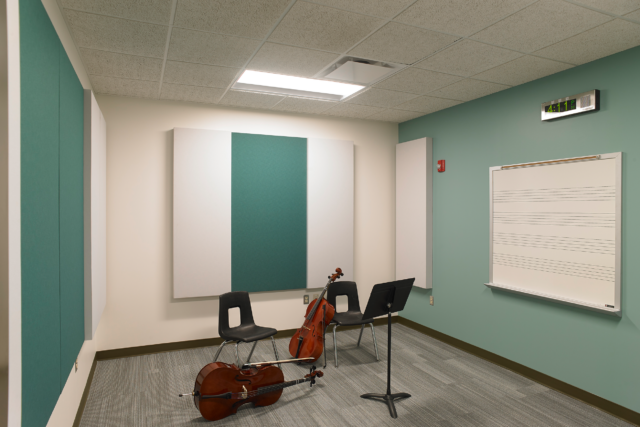Keeping Spaces Sound

Eleven million students nationwide are subject to poor acoustics within their classrooms. How does that inhibit education, and what can we do about it?
Bad acoustics impact learning. At least according to the American Institute of Architects (AIA), whose research shows that young students are more susceptible than adults to the interference of background noise and excessive reverberation on learning. Numerous factors contribute to a school’s acoustical environment— reverberation time, background noise, and sound transmission from adjoining areas can all interrupt learning. Controlling these factors is important to achieve a good acoustical environment, which is necessary for optimal learning. Here are the basics to start a conversation with your design team.
Reverberation
All materials have the ability to absorb sound. Soft porous materials, however, are more absorptive than hard ones. Rooms with many hard surfaces have a longer reverberation time (the property of a space based on how rapidly it absorbs sounds generated within it). Each room has an ideal reverberation time based on its size and use.
Acoustical engineers can tune a room to the correct reverberation time by controlling the amount of sound-absorbing material. A tremendous range of acoustical treatment materials are available and can be attractively (and affordably) incorporated into virtually any room design. How much reverberation should a room have?
- Music rooms can have longer reverberation times to add warmth to music.
- Classrooms and lecture halls should have very short reverberation times to enhance speech intelligibility.
- Gyms should have enough reverberation to generate excitement during a game, but not so much that crowd levels become deafening or that music sounds muddy.
Background Noise
Background noise can include outdoor sources— like highways, aircraft, and railroads—or indoor sources, which are most commonly mechanical equipment such as HVAC, lighting, and plumbing. Outdoor interference is easily prevented by thoughtful envelope design, but control of indoor noises is trickier.
HVAC noise can be controlled through careful equipment selection, application of lagging materials, controlling air velocities in ducts, and use of vibration isolators. An acoustical engineer can determine background noise levels before a space is built, and ensure that systems will be sufficiently quiet to minimize interference by working with the project’s mechanical engineer.
In some spaces, a degree of HVAC generated “white noise” is desirable since it can enhance the sense of privacy by masking sounds that travel to unintended listeners. “White noise” generators are sometimes installed where speech privacy is critically important, such as in a counselor or dean’s office.
Sound Transmission
Sound inevitably travels from one space to another through cracks around doors, over partitions, and even directly through barriers. The ability of a material to stop sound transmission is rated using the STC system, which stands for “sound transmission class.” Most construction materials and assemblies have been tested in sound laboratories to establish these ratings.
The intended STC of a wall, floor, or ceiling assembly should be selected based on the amount of privacy desired. Obviously, a higher STC rating is required between a classroom and a gym than between a classroom and an office. Very high levels are required to isolate music practice rooms from other areas.
A 1981 study showed that students exposed to bad acoustics performed more poorly on tests than students accustomed to healthy acoustics. This testing gap persisted when students solved easy problems in quiet rooms, suggesting that subjection to bad acoustics can have long-term ramifications. LaBella’s in-house acoustics specialists help our clients address acoustics at every stage of their project.